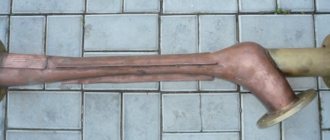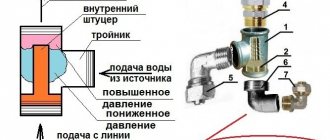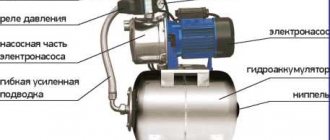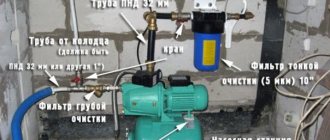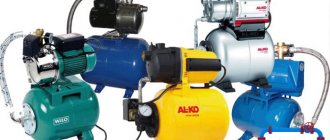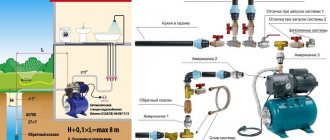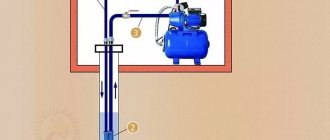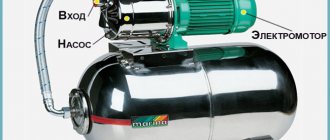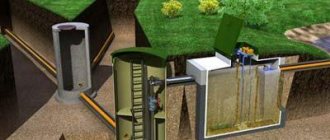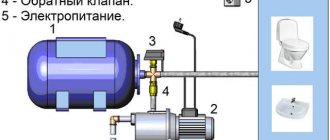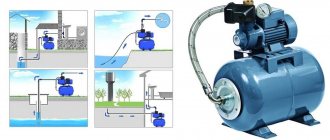Choice of built-in or external
Depending on the installation location, there are remote and built-in ejectors. There is no big difference in the design features of these devices, but the location of the ejector still affects in some way both the installation of the pumping station and its operation.
So, built-in ejectors are usually placed inside the pump housing or in close proximity to it. As a result, the ejector takes up minimal space and does not have to be installed separately; it is enough to carry out the usual installation of the pumping station or the pump itself.
In addition, the ejector located in the housing is reliably protected from contamination. Vacuum and reverse water intake are carried out directly in the pump housing. There is no need to install additional filters to protect the ejector from clogging with sludge particles or sand.
However, it should be remembered that this model demonstrates maximum efficiency at shallow depths, up to 10 meters. Pumps with a built-in ejector are designed for such relatively shallow sources; their advantage is that they provide excellent incoming water pressure.
As a result, these characteristics are sufficient to use water not only for domestic needs, but also for irrigation or other economic operations. Another problem is the increased noise level, since the vibration of the operating pump is added to the sound effect of water passing through the ejector.
If you decide to install a pump with a built-in ejector, you will have to take special care of sound insulation. It is recommended to install pumps or pumping stations with a built-in ejector outside the house, for example, in a separate building or in a well caisson.
The electric motor for a pump with an ejector must be more powerful than for a similar model without an ejector.
An external or external ejector is installed at a certain distance from the pump, and this distance can be quite significant: 20-40 meters, some experts even consider 50 meters acceptable. Thus, a remote ejector can be placed directly in a water source, for example, in a well.
The external ejector does not so much increase the pump’s performance as it is designed to increase the depth of water intake from the source, which can reach 20-45 m
Of course, the noise from the operation of an ejector installed deep underground will no longer disturb the residents of the house. However, this type of device must be connected to the system using a recirculation pipe through which the water will return to the ejector.
The greater the installation depth of the device, the longer the pipe will have to be lowered into the well or well.
It is better to provide for the presence of another pipe in the well at the design stage of the device. Connecting a remote ejector also involves installing a separate storage tank from which water will be drawn for recirculation.
Such a tank allows you to reduce the load on the surface pump, saving some energy. It is worth noting that the operating efficiency of the external ejector is somewhat lower than that of models built into the pump, however, the ability to significantly increase the intake depth makes one come to terms with this drawback.
When using an external ejector there is no need to place it directly near a water source. It can be installed in the basement of a residential building. The distance to the source can vary within 20-40 meters; this will not affect the performance of the pumping equipment.
Design and types of pumps with ejectors
There are two options for including an ejector in the pump circuit:
- built-in;
- external node.
Functionally, these methods differ. The choice depends on the tasks that will be assigned to the pump. The built-in ejector is located in the pump design, so the suction of liquid and the creation of pressure occur inside the device. In this case, the pump, of course, is also immersed in the well.
On the one hand, this reduces the overall dimensions of the installation. Such a pumping station is capable of working with liquid containing sand and silt. However, the device itself is quite noisy, so it is not installed near a residential building. The maximum water intake depth of such a pump is only about 8 m.
A remote ejector involves equipment of a ground pumping station. The unit itself is placed in the pipeline at depth. A tank is placed on the surface, which facilitates the operation of the pump: it creates pressure and additional vacuum. Among the disadvantages of such a device is the need to lower the second pipe, which can be inconvenient if the well diameter is limited.
The efficiency of a pump with a remote ejector is 30-35% lower than that of a “colleague” with a built-in one. But you can get water from a depth of up to 50 m. And it works much quieter. It is even placed in houses, although not in living rooms.
Attention! The remote ejector, pump and related equipment operate effectively even at a distance of 20-40 m from the well.
Difference from injector
Both of these devices are jet devices, that is, for suctioning liquid and gaseous substances.
An ejector is a device in which kinetic energy is transferred from a working medium at high speed to a non-working, that is, passive, medium through their displacement.
Injector - device
, in which gases and liquids are compressed.
The main difference between these devices is the method of transmitting energy to the passive medium. For example, in an injector the supply occurs due to pressure, and in an ejector the supply occurs due to the creation of a self-priming effect.
Almost everywhere you can connect an autonomous water supply to your house. However, the main problem is the depth of groundwater. If the water in the prepared well is at a level of 5-7 meters, then no special problems can be expected, because then you can use almost any type of pump that is suitable in terms of power and performance. If the water is much deeper, then an ejector for pumping stations comes to the rescue.
How to extend the life of the ejector
To extend their service life, pumping stations with an ejector must be operated in compliance with the following rules:
When installing a station, it is important to correctly calculate the ratio of the power of the device and the depth of the source from which water is extracted. Constantly monitor the pressure in the pipeline
To measure the pressure in the system, you can use a pressure gauge used for car tires or purchase a station with a special built-in sensor; for sources with great depth, it is necessary to purchase a powerful pump, which must be installed as close as possible to the water intake; the use of a built-in ejector is justified only at high-power stations; when the source depth is from 15 to 40 meters, it is necessary to use a remote ejector installed inside the well and located in the water. When using a surface-type pump, it is important to correctly install the pipes coming from the surface of the ejector - strictly vertically. If the pipes are positioned incorrectly, air will enter the system and air pockets will form, which will negatively affect the operation of the system and reduce its service life.
If all operating rules are followed, ejector pumping stations operate uninterruptedly and provide tap water to the home, irrigation and other equally important household needs.
Features of installation and operation
The operation of the ejector will be effective only on powerful pumps, at least 1 kW with high productivity, and the installation depth of the ejector is no more than 20 m; installation deeper sharply reduces the efficiency of the ejector. To ensure that there are no malfunctions when operating a pump with a remote ejector, the supply pipes to the ejector must be placed strictly vertically. It is imperative that there is a coarse filter in front of the pump, since such pumps are very vulnerable to the effects of abrasive particles that can damage the pump. In front of the pump, on the recirculation pipeline, it is necessary to install a tap so that you can regulate the amount of return water, thereby regulating the suction efficiency of the ejector.
Advantages, principle of operation and installation details
A surface pump with an external ejector has the following advantages:
- work with great depths up to 50 meters;
- small dimensions and weight of the station;
- convenience of supplying water to the object;
- ability to work in extreme conditions – at temperatures from -20 to + 130 degrees.
Design and principle of operation of the internal ejector
Of course, not every steam ejector pump can boast all of the above advantages. So, some models can work in severe frost conditions, others cannot.
How does the device work?
The steam ejector pump has a fairly simple principle of operation - a small amount of water, which is located in a special tank of the device, is used to assist in drawing in liquid. The operating principle is simple but very effective.
Water supply station with ejector
Device. Operating principle
An ejector is essentially a device that transfers energy from one more mobile medium to another, which is less mobile. In the tapering sections of the unit, a special zone of lower pressure is formed, which thus provokes the suction of additional medium. Thus, it is possible to move and move away from suction points, due to the interaction of the original environment.
Units equipped with an internal format ejector are intended directly for specialized pumping of liquids from relatively shallow wells, the depth of which does not exceed eight meters, as well as various specialized storage tanks or reservoirs.
The immediate distinctive feature of this interaction is precisely the capture of liquid, which is located at a lower level from the pipe. Based on this, preliminary filling of the unit with water will be required. The working wheel will pump liquid, which will redirect it to the ejector, resulting in the formation of an ejection jet.
It will move through a specialized tube and accelerate. Naturally, the pressure will decrease. Thanks to this effect, it will also decrease inside the suction chamber.
One of the varieties of such surface installation units is a pumping station with an ejector. They differ in that the external element is immersed in the water supply source. As a rule, the scope of application of such devices is similar to their analogues. The definite difference lies in the different depths of use and application.
Design features
This device contains a pump with an electric motor, a hose that is necessary to connect to the pump, a water filter, and a check valve. In addition to the listed components, we can highlight a pressure gauge, an electrical power cable, a pressure switch and a hydropneumatic tank, the capacity of which can range from 18 to 100 liters.
Such equipment is easy to install and fully operational. It is important to purchase units that are equipped with mechanisms to protect against the human factor, which also plays a big role.
Ejector pumping station
A pumping station with a built-in ejector is a set of equipment originally designed to perform work under certain conditions. The main parameters that are taken into account when choosing are power and performance. The first characteristic means the ability to maintain pressure in the system, as well as the ability to retain a water column and transmit liquid over a distance through a horizontal pipeline.
The second characteristic is productivity. This is the amount of liquid pumped per unit of time. This parameter cannot be greater than the well flow rate. If we are talking about purchasing a pumping station with a built-in ejector, then the technical documentation indicates the general output characteristics. This means that no additional calculations will have to be made.
The equipment is connected according to the attached instructions. The hoses are attached using clamps included in the kit. The pipeline requires a threaded connection. The main thing is to provide a place for installation so that rain and frost cannot damage the system. For this, a caisson is made or a separate building is built. The canopy is only suitable for a summer house that is not intended for year-round use.
A pressure gauge is installed as additional equipment for a pumping station with an ejector, if this is not provided by the manufacturer. Thanks to this device, you can control the pressure in the pipeline. Naturally, it is installed at the exit of the station. If the well depth is within 15-40 meters, experts recommend installing a surface pump with a remote ejector.
Connection diagram
The best connection scheme involves connecting the station to the ejector only with a vertical pipe. Otherwise, airing is possible, which leads to a decrease in system performance. If this is not possible, you need to take care of shut-off valves to bleed air as necessary.
Types of ejectors
Ejector pumps can be steam, steam jet and gas. The general principle of their operation is identical. But the devices are activated in different ways. A pump with a steam-type ejector is used to pump out gaseous media from a closed volume. You can maintain the pressure at a negative level, making the environment rarefied. Scope of application: industry.
Steam jet design designed to work with gaseous media and liquids. The difference in the operation of an ejector device of this type is that the steam passing through the nozzle draws the pumped medium with it at high speed. Given their high performance, the scope of application of these devices is urgent pumping of water, for example, on a ship.
Gas type is a separate category of ejectors. The devices operate on compressed gas, which, mixed with the pumped medium, is directed into a diffuser to slow it down. After its passage, the mixture escapes through the nozzle hole. Such devices are intended mainly for the gas industry.
Built-in models
When understanding what an ejector is, it is necessary to consider the classification of these devices depending on the installation location. Built-in models are part of the structure, or rather, its component. The ejector can be attached to the pump itself or next to it on a single frame. Installation consists of attaching the block to the base and connecting the forces
The scheme works when water rises from a depth of 10 meters. The exact parameters are indicated in the technical documentation.
Installation is recommended to be done outside the home. This may be a well with a head installed, or a separate building. The reason for this is increased noise and vibration. If this is not possible, consider the following type of installation.
Remote models
In this case, the circuit must be supplemented with an additional tank for pumping liquid. The well must be wide enough to accommodate two hoses. Productivity in this case will decrease by a third due to a decrease in the diameter of the intake pipe. You will also need a separate pipeline for air supply.
But with this configuration, a vacuum area is created in the gas intake, which allows you to lift liquid from a height of more than 50 meters. In this case, the distance from the well to the consumer can be more than 40 meters. In this case, the pumping station can be installed indoors inside the house. This could be a basement, boiler room, storage room, etc.
How does an ejector work?
The principle of operation of the ejector is based on the movement of water in the pipe, which, when entering the smoothly tapering part of the ejector, increases its speed, as a result of which a zone with reduced pressure is formed, into which water is sucked in from the outside. The remote ejector of the pumping station operates by supplying water through a recirculation pipeline; the flow, entering the tapering part, increases speed, forming a zone with reduced pressure, where water from the outside begins to be sucked in to compensate for the low pressure. In other words, the ejector pushes water to a height from which the pump can independently suck it up.
The efficiency of the ejector is characterized by the ejection coefficient, which shows the amount of sucked water per unit amount of recirculated water. In our case, the water ejection coefficient is 0.12, that is, with a water flow rate in the ejector of 1000 l/hour, the ejector will suck in about 120 l/hour.
Choice of built-in or external
Depending on the installation location, there are remote and built-in ejectors. There is no big difference in the design features of these devices, but the location of the ejector still affects in some way both the installation of the pumping station and its operation.
So, built-in ejectors are usually placed inside the pump housing or in close proximity to it. As a result, the ejector takes up minimal space and does not have to be installed separately; it is enough to carry out the usual installation of the pumping station or the pump itself.
In addition, the ejector located in the housing is reliably protected from contamination. Vacuum and reverse water intake are carried out directly in the pump housing. There is no need to install additional filters to protect the ejector from clogging with sludge particles or sand.
However, it should be remembered that this model demonstrates maximum efficiency at shallow depths, up to 10 meters. Pumps with a built-in ejector are designed for such relatively shallow sources; their advantage is that they provide excellent incoming water pressure.
As a result, these characteristics are sufficient to use water not only for domestic needs, but also for irrigation or other economic operations. Another problem is the increased noise level, since the vibration of the operating pump is added to the sound effect of water passing through the ejector.
If you decide to install a pump with a built-in ejector, you will have to take special care of sound insulation. It is recommended to install pumps or pumping stations with a built-in ejector outside the house, for example, in a separate building or in a well caisson.
The electric motor for a pump with an ejector must be more powerful than for a similar model without an ejector.
An external or external ejector is installed at a certain distance from the pump, and this distance can be quite significant: 20-40 meters, some experts even consider 50 meters acceptable. Thus, a remote ejector can be placed directly in a water source, for example, in a well.
Of course, the noise from the operation of an ejector installed deep underground will no longer disturb the residents of the house. However, this type of device must be connected to the system using a recirculation pipe through which the water will return to the ejector.
The greater the installation depth of the device, the longer the pipe will have to be lowered into the well or well.
It is better to provide for the presence of another pipe in the well at the design stage of the device. Connecting a remote ejector also involves installing a separate storage tank from which water will be drawn for recirculation.
Such a tank allows you to reduce the load on the surface pump, saving some energy. It is worth noting that the operating efficiency of the external ejector is somewhat lower than that of models built into the pump, however, the ability to significantly increase the intake depth makes one come to terms with this drawback.
When using an external ejector, there is no need to place the pumping station directly near the water source. It can be installed in the basement of a residential building. The distance to the source can vary within 20-40 meters; this will not affect the performance of the pumping equipment.
Types of ejector devices
According to their design and operating principle, ejector pumps can belong to one of the following categories.
Steam
With the help of such ejector devices, gaseous media are pumped out of confined spaces and a rarefied state of air is maintained. Devices operating on this principle have a wide range of applications.
Steam ejector for turbine with oil cooler
Steam jet
In such devices, the energy of a steam jet is used to suck gaseous or liquid media from a confined space. The operating principle of this type of ejector is that steam escaping from the nozzle of the installation at high speed carries with it the transported medium exiting through an annular channel located around the nozzle. Ejector pumping stations of this type are used primarily for rapid pumping of water from the premises of ships for various purposes.
Installation of water heating using a steam jet ejector
Gas
Stations with an ejector of this type, the operating principle of which is based on the fact that the compression of a gas medium, initially under low pressure, occurs due to high-pressure gases, are used in the gas industry. The described process takes place in the mixing chamber, from where the flow of the pumped medium is directed to the diffuser, where it is slowed down, and hence the pressure increases.
Air (gas) ejector for chemical, energy, gas and other industries
With remote ejector
To extract water, such pumps must be lowered deep into a well or borehole. A pump with a remote ejector has two pipes. According to one of them, liquid under a certain pressure is supplied to the ejector. This leads to the development of a kind of suction jet.
A pump with an external ejector is significantly inferior in its characteristics to models with a built-in ejector. It's all about the specifics of the design.
Installation diagram of two types of ejector pumps
Thus, a pump with a remote-type ejector will be “afraid” of contaminated water and air entering the structure. Its efficiency is noticeably lower, but the pump’s remote ejector also has its own significant advantage - it can be located inside a living room.
With built-in ejector
An internal centrifugal ejector pump lifts water using artificially created vacuum.
Due to its design features, an ejector pump is much more expensive than conventional devices of this type, as it is capable of lifting water even from great depths up to 50 meters.
High performance, however, is somewhat compensated for by the high level of noise emitted during operation of the device.
Therefore, ejector pumps are installed exclusively in basements and utility rooms of residential buildings.
A modern steam ejector vacuum electric pump is a good solution for organizing a water supply system in a large enterprise and for irrigating large areas with vegetation.
Ejector design option 1
The simplest ejector can be assembled based on a tee and fitting - these parts will perform the function of a Venturi tube in a very simplified version. Shaped elements for the ejector can be used from various materials (metal, plastic). In this case, the ejector structure is assembled from a brass tee and collet fittings for metal-plastic pipes.
The diameter of the shaped elements for the ejector design is taken depending on the performance of the pumping station and the diameter of the suction and recirculation pipeline; the diameter of the suction pipeline cannot be less than 25 mm. In our design, a tee with a diameter of 20 mm will be used with a 26 mm suction pipeline and a 12.5 mm recirculation pipeline connected to it.
- Tee ½" mm.
- Fitting ½" mm and with a 12 mm outlet.
- Adapter 20×25 mm.
- Angle 90º (external/internal) for metal-plastic pipe ½"×16 mm.
- Angle 90º (external/internal) for metal-plastic pipe ¾"×26 mm.
- Angle 90º (external/internal) ¾"×½".
The lower base of the resulting cone should have a diameter several millimeters smaller than the outer diameter of the fitting thread, and its thread should also be shortened so that a maximum of four turns remain. Using a die, you need to drive the thread and cut a few more turns on the resulting cone.
Now you can assemble the ejector. To do this, we screw the fitting (2) with its narrow part inside the tee (1) so that the fitting extends 1–2 mm beyond the upper edge of the side outlet of the tee, and so that at least four turns remain on the internal thread of the tee so that the outlet can be screwed in (6). If the remaining free thread of the tee is not enough, you will need to grind off the threads of the fitting; if the length of the fitting is not enough, you can put a piece of tube on it. A check valve must be connected to the outlet (5) through which water will be suctioned, so that when the system starts, water does not flow out of the suction and recirculation water supply, otherwise the system will not start. You also need to seal all threaded connections using any sealant.
Such an ejector will not have a high ejection coefficient due to the imperfect design of the Venturi tube, so it can be used to lift water from a depth of no more than 10 m.
Ejector pumps
The procedure for connecting an ejector as an independent device consists of two stages:
- An additional pipe is laid according to all the rules that were taken as the basis when installing the water supply pipeline. An additional pipe is needed to supply the injection medium.
- Connecting the pipe to the suction unit. It is necessary to install a coarse filter and a return pipe. It is recommended to install a valve to regulate the operation of the system.
The valve is necessary if the water level in the pit is higher than that for which the pump is designed. In this case, you can adjust the discharge flow.
Features and principle of operation of the installation
At factories producing wastewater disposal equipment, 2 types of pumping equipment are manufactured - with an internal and external ejector pump.
Devices with an internal ejection device pump out water from shallow (8 m or less) wells, reservoirs and wells.
A feature of such equipment is the presence of a “self-priming” function, as a result of which the water level is regulated, which is below the level of the inlet pipe. In this regard, before turning on the device, it is necessary to fill it with water.
After the device is filled with water and turned on, the impeller of the installation with an internal ejector pump sends water to the inlet of the ejector, thereby forming the necessary jet. It moves through a thin tube and the water pressure becomes faster.
When a pipe is connected to the inlet pipe, water begins to flow into the station.
The water then enters a chamber which sucks up the liquid. At the same time, the water pressure becomes less and the liquid flows through the diffuser to the outlet, slightly increasing the flow speed.
A device that uses an external ejector for a pumping station differs from an internal ejection pump in that it is used only at a depth of 10 m or more.
It is also difficult to install external ejector pumps on these devices. The pipes that connect the pumping devices to each other are installed only in a vertical position. Otherwise, a lot of air will enter the inlet line and it will stop working normally.
The optimal option for using devices with a remote ejector is to install the device at a depth of 20 m. As the lifting height increases, its performance decreases.
As a result, the external pumping device has less efficiency than the internal one.
Pumping station with remote ejector
Manufacturing
It is quite possible to produce a fairly simple device-unit independently. This will require some parts, such as a tee of a specialized diameter and a fitting that will be located inside it. The correct length ratio must be observed, which should not be more or less, which will not allow such a device to function normally. For fastening you will need a special adapter equipped with corners, which will allow you to create the desired rotation.
The creation process involves several specific points, which includes the process of preparing the required fitting itself. Part of a special 6-sided sample should be ground, which will allow it to be made into a special cone, having a base smaller than the external thread in diameter. After which the deformed part should be corrected with a specialized thread-cutting tool.
The fitting must be screwed all the way into the tee piece. When connecting, be very careful about the length ratio, which is a fairly important factor. Be sure to seal the connection with any available sealant.
Check the ratio of the parts being manufactured, and then from pre-prepared samples you should organize a specialized adapter, which is designed for installation on the pipe.
A well-assembled station will ensure fairly long and trouble-free operation due to its simple design, but, naturally, you must be extremely precise in manufacturing. If you don’t really want to engage in such production, then you can simply purchase it in specialized stores, where a pumping station is always available for free sale.
Device Features
The ejector device is very simple; it can even be assembled manually from ordinary materials. The design of the device consists of the following parts:
- Diffuser;
- Offset node;
- Water suction chamber;
- Nozzle narrowed downwards.
The operation of the device is based on Bernoulli's law. When the speed of a certain flow increases, a field with a low level of pressure is created around it. In this regard, a
discharge effect is created. The liquid, passing through the nozzle, narrowed downward according to its design, gradually increases speed. After which the liquid, entering the mixer, creates low pressure in it. Thus, the pressure of the liquid that enters the mixer through the water suction chamber increases significantly.
It is also worth noting that for the ejector to work properly, it must be installed on the pump so that some of the liquid that rises with the help of the pump remains inside the device, or more precisely, the nozzle, creating the necessary pressure constantly
. It is thanks to this operating principle that it is possible to maintain a constant accelerated flow. Using such a device can significantly save energy.
Operating principle of the ejector
The deeper the water is, the more difficult it is to bring it to the surface. In practice, if the well depth is more than seven meters, the surface pump has difficulty coping with its tasks.
Of course, for very deep wells it is more appropriate to purchase a high-performance submersible pump. But with the help of an ejector, it is possible to improve the performance of a surface pump to an acceptable level and at significantly lower cost.
The ejector is a small but very effective device. This unit has a relatively simple design; you can even make it yourself from scrap materials. The operating principle is based on giving the water flow additional acceleration, which will increase the amount of water coming from the source per unit of time.
This solution is especially convenient for those who are going to install or have already installed a pumping station with a surface pump. The ejector will allow you to increase the depth of water intake to 20-40 meters.
It should also be noted that the purchase of more powerful pumping equipment will lead to a noticeable increase in energy consumption. In this sense, the ejector will bring noticeable benefits.
The ejector for a surface pump consists of the following elements:
- suction chamber;
- mixing unit;
- diffuser;
- narrowed nozzle.
The operation of the device is based on Bernoulli's principle. It states that if the speed of a flow increases, an area of low pressure is created around it. In this way, a rarefaction effect is achieved. Water enters through a nozzle, the diameter of which is smaller than the size of the rest of the structure.
This diagram allows you to get an idea of the design and operating principle of an ejector for a pumping station. The accelerated reverse flow creates an area of low pressure and transfers kinetic energy to the main flow of water
A slight narrowing gives the water flow a noticeable acceleration. Water enters the mixer chamber, creating an area of reduced pressure inside it. Under the influence of this process, a stream of water under higher pressure enters the mixer through the suction chamber.
Water enters the ejector not from the well, but from the pump. Those. The ejector must be installed in such a way that part of the water raised by the pump returns to the ejector through the nozzle. The kinetic energy of this accelerated flow will be constantly transferred to the mass of water that is absorbed from the source.
To create an area of rarefied pressure inside the ejector, use a special fitting, the diameter of which is smaller than the parameters of the suction pipe
This will ensure constant acceleration of the flow. Pumping equipment will require less energy to transport water to the surface. As a result, its efficiency will increase, as will the depth from which water can be drawn.
Part of the water extracted in this way is again sent through the recirculation pipe to the ejector, and the rest enters the water supply system of the house. The presence of an ejector has another “plus”. It sucks up water on its own, which additionally protects the pump from running idle, i.e. from the “dry running” situation, which is dangerous for all surface pumps.
The diagram shows the structure of the external ejector: 1- tee; 2 - fitting; 3 — adapter for water pipe; 4, 5, 6 - corners
To regulate the operation of the ejector, use a regular tap. It is installed on a recirculation pipe, through which water from the pump is directed to the ejector nozzle. Using a tap, the amount of water entering the ejector can be reduced or increased, thereby reducing or increasing the rate of return flow.
Types of ejectors at installation site
When purchasing an ejector to equip a pumping station, keep in mind that such a device can be built-in or external. The design and principle of operation of these two types of ejectors are practically no different; the differences are only in the location of their installation. Built-in ejectors can be placed inside the pump housing or mounted in close proximity to it. The built-in ejection pump has a number of advantages, which include:
- minimum space required for installation;
- good protection of the ejector from contamination;
- there is no need to install additional filters that protect the ejector from insoluble inclusions contained in the pumped liquid.
Centrifugal pump with built-in ejector
Meanwhile, it should be borne in mind that built-in ejectors demonstrate high efficiency if they are used to pump water from sources of shallow depth - up to 10 meters. Another significant disadvantage of pumping stations with built-in ejectors is that they produce quite a lot of noise during their operation, so it is recommended to locate them in a separate room or in a caisson of a water-bearing well. It should also be borne in mind that the design of an ejector of this type involves the use of a more powerful electric motor, which drives the pumping unit itself.
A remote (or external) ejector, as its name suggests, is installed at a certain distance from the pump, and it can be quite large and reach up to fifty meters. Remote-type ejectors, as a rule, are placed directly in the well and connected to the system via a recirculation pipe. A pumping station with a remote ejector also requires the use of a separate storage tank. This tank is necessary to ensure that water is always available for recirculation. The presence of such a tank, in addition, makes it possible to reduce the load on the pump with a remote ejector and reduce the amount of energy required for its operation.
Pump with external ejector
The use of remote-type ejectors, the efficiency of which is slightly lower than that of built-in devices, makes it possible to pump out a liquid medium from wells of considerable depth. In addition, if you make a pumping station with an external ejector, then it can not be placed in the immediate vicinity of the well, but can be mounted at a distance from the water intake source, which can be from 20 to 40 meters
It is important that the location of pumping equipment at such a significant distance from the well will not affect the efficiency of its operation
In what cases is an ejector needed?
Before dealing with the question of what an ejector is, you should find out why a pumping station equipped with it is needed. Essentially, an ejector (or ejector pump) is a device in which the energy of motion of one medium moving at high speed is transferred to another medium. Thus, the operating principle of an ejector pumping station is based on Bernoulli’s law: if a reduced pressure of one medium is created in a narrowing section of the pipeline, this will cause suction into the formed flow of another medium and its transfer from the suction point.
Everyone knows well: the greater the depth of the source, the harder it is to raise water from it to the surface. As a rule, if the depth of the source is more than seven meters, then a conventional surface pump has difficulty performing its functions. Of course, to solve this problem, you can use a more productive submersible pump, but it is better to go the other way and purchase an ejector for a surface-type pumping station, significantly improving the characteristics of the equipment used.
External ejector prepared for immersion into the well
By using a pumping station with an ejector, the liquid pressure in the main pipeline increases, while the energy of the fast flow of the liquid medium flowing through its separate branch is used. Ejectors, as a rule, work in conjunction with jet-type pumps - water-jet, liquid-mercury, steam-mercury and steam-oil.
An ejector for a pumping station is especially relevant if it is necessary to increase the power of an already installed or planned installation of a station with a surface pump. In such cases, the ejector installation allows you to increase the depth of water intake from the reservoir to 20–40 meters.
